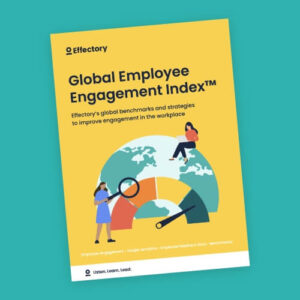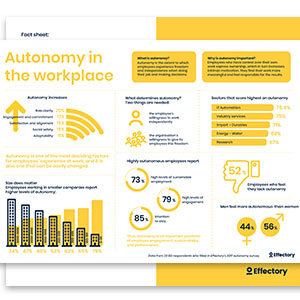The term work-life balance can be somewhat confusing, as it implies that work and private lives are two separate entities. In reality, the two are increasingly becoming intertwined into one.
How to create a good work-life balance

Results from our employee surveys illustrate that the balance between work and home is becoming increasingly important for employees. So, why is this? And what can both employees and organisations do to ensure a healthy work-life balance?
The balance between work and private
How have work and life become so intertwined?
On the one hand, it’s a generational issue. The current generation of employees – the generations after the post-war generation – no longer want to work, work, work, work. They’ve witnessed what all work and no play can do and have been bought up in relative luxury. Their demands are higher, they prioritise having a nice life over a working one and this ultimately blurs the boundaries between work and private life.
Workloads in multinationals: a cause for concern?
On the other hand, it has to do with the way that work itself has transformed. Where once the emphasis was placed on the presence of employees, it’s now placed upon of the added value and output of employees. When you combine this with the opportunity for more flexible work schedules, we see a tremendous interweaving of both work and life.
What is work and what is private?
The distinction between work and private life is relevant, but is not, the most important. What you should be asking is: are my work and private life in balance?
From there on, making distinctions between the two are easier. Questioning what lies in your work sphere and what lies in your private sphere can help determine what work is, what private is, and more importantly, where the balance is.
Don’t be fooled by others
The trick is to realise that you have a life, and that work is a part of it. The quality of your life, including your work, has to be sufficient. Considering the emphasis on added value, you naturally pay attention to your own added value. You keep an eye on how much time you spend on non-work related activities, and relaxing.
None the above contributes to a bad work-life balance. One of the most common aspects that fools people when it comes to evaluating their own work-life balance, is judging other people’s work-life balance. Employees often compare their own work-life balance to their co-workers. Big Mistake! Comparing your balance with your co-workers will only drive you crazy, and is the equivalent to comparing apples and coconuts. It’s important to remember that you have to find the right balance that fits you and your life, not someone else’s.
Global Employee Engagement Index™
Discover the Global Employee Engagement Index™ 2025 for key insights on driving employee engagement, improving performance, and enhancing team dynamics.
DownloadPart-time versus full-time
Many employees reduce their hours in an attempt to gain a better balance between work and private life. The employee surveys that we conduct at Effectory International have shown us that reducing hours does not automatically improve employee’s work-life balance. Results have shown us that part-time employees don’t have a better work-life balance than full-time employees do.
The unbalance is partly due to the higher demands and expectations that part-time workers put on their work-life balance. An additional factor is the need for part-time employees to complete more work in fewer days. So in practice whilst reducing hours may seem like a solution, the work-life balance is still about the quality of people’s private life in comparison to their work life.
Workloads in multinationals: a cause for concern?
Flexible work: freedom and responsibility
As mentioned above, working environments have changed. Many organisations have embraced a more flexible working environment, which has given employees more freedom. The consequence for employee absence is that employees take fewer sick days, but longer absences. Long term absences increase within organisations that have flexible working environments.
The new flexible work environments should be commended, but employees need to see for themselves if they can cope with this new mix of freedom and responsibility. If you can find a good balance between them, it can be great. Where it goes wrong is when people have the freedom but don’t take the responsibility. This usually becomes clear pretty quickly, and action can be taken.
Employee’s work-life balance can also go wrong if people take the responsibility, but not the freedom. People know that they’re being judged on the value they add, and so they want to perform and they have the resources to work at any time in any place. So they do. Although this is a lot harder to trace, such mentalities are a great source of long term failure in the future.
HR Analytics: Autonomy data infographic & fact sheet
Get data-driven insights about autonomy in the workplace by downloading this infographic and fact sheet.
DownloadGive employees a voice
What can organisations do to avoid overstrain and burnouts?
Firstly, talk to employees about it and work with them to create awareness. Open a dialogue about the dangers of only taking the responsibility for their work and not enjoying the freedom. Trainings can be a vital asset in organisations, as it can help employees effectively time manage and organise priorities.
Why employee vitality and well-being is so important
Secondly, monitor employees. This needs to be done by all levels of the organisation. If managers are left with the sole responsibility of monitoring employees, how will organisations monitor manager’s work-life balance? If managers are not monitored, they can become at risk from the very thing they are supposed to be preventing and, furthermore, can set a bad example for their employees.
Book a free demo. See our solutions in action.
Effectory is Europe’s Leading provider of Employee Listening Solutions. Schedule a product demo and discover how to enhance your employees’ engagement.
Demo request

